Jennifer Bohnhoff's Blog, page 4
March 31, 2025
Oral History as Distant Memory
 Back when I was writing The Last Song of the Swan, my novel retelling the Beowulf story in both the distant past and the present, one of the major questions I wanted to answer is whether oral history remembered events from long ago. I wondered then if Grendel, the monster in Beowulf, could be a Neanderthal.
Back when I was writing The Last Song of the Swan, my novel retelling the Beowulf story in both the distant past and the present, one of the major questions I wanted to answer is whether oral history remembered events from long ago. I wondered then if Grendel, the monster in Beowulf, could be a Neanderthal.
 This month Kinkajou Press, a division of Artemesia Publishing will release In the Shadow of Sunrise, a novel set in New Mexico 11,000-10,000 years ago, during the time that the people now called Folsom man wandered the area, and the same question, in a slightly different context, has popped up again. Can old stories remember events from thousands of years before their telling?
This month Kinkajou Press, a division of Artemesia Publishing will release In the Shadow of Sunrise, a novel set in New Mexico 11,000-10,000 years ago, during the time that the people now called Folsom man wandered the area, and the same question, in a slightly different context, has popped up again. Can old stories remember events from thousands of years before their telling?
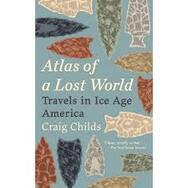 In his book Atlas of a Lost World, Craig Childs asks the same question. He points out that many Native American oral traditions refer to giant, dangerous animals who walked the world when it was new. In most of those stories, there are heroes who are monster slayers, or who drive the beasts into the underworld so that man can live unmolested by them. Childs wonders if these heroes are the Clovis people, who left evidence that they were here 12,000–11,000 years ago. If so, the monsters might be the megafauna that lived in North America at the close of the last Ice Age. He wonders, particularly, if these monsters aren't the mammoths and mastodons that roamed the grasslands.
In his book Atlas of a Lost World, Craig Childs asks the same question. He points out that many Native American oral traditions refer to giant, dangerous animals who walked the world when it was new. In most of those stories, there are heroes who are monster slayers, or who drive the beasts into the underworld so that man can live unmolested by them. Childs wonders if these heroes are the Clovis people, who left evidence that they were here 12,000–11,000 years ago. If so, the monsters might be the megafauna that lived in North America at the close of the last Ice Age. He wonders, particularly, if these monsters aren't the mammoths and mastodons that roamed the grasslands.
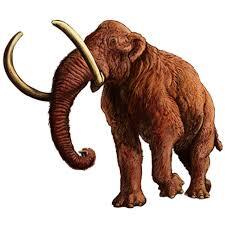 Childs shares a story shared in 1934 in American Anthropology. According to a Penobscot legend from Maine, there was once a hero named Snowy Owl who discovered that watercourses were drying up. When he sought the reason why, he found great animals with backs like hills and long teeth, who drank for half a day at a time. Snowy Owl shot them all, restoring water to the valley.
Childs shares a story shared in 1934 in American Anthropology. According to a Penobscot legend from Maine, there was once a hero named Snowy Owl who discovered that watercourses were drying up. When he sought the reason why, he found great animals with backs like hills and long teeth, who drank for half a day at a time. Snowy Owl shot them all, restoring water to the valley.Backs like hills? Long teeth? Could these monsters be mammoths or mastodons? In 1781, Thomas Jefferson learned of a Mr. Stanley, who had been taken prisoner by Indians, but escaped and returned east. Stanley had been taken somewhere west of the Continental Divide, where he claimed to have seen bones bigger than any known living land animal. The natives described the animal these bones came from, and said that it still existed in the northern part of the territory. Mr. Stanley believed they were elephants.In the 1700s, fossils were often said to be the remains of animals that had not gotten on the ark when Noah had save the earth's fauna from the great flood. But what if some of them had survived? What if they still existed in the wilds of the American west?Jefferson had already heard of a place named Big Bone Lick, Kentucky, where mammoth bones had been found. The bones were just that: bones. They had not been mineralized into fossils.Jefferson was so intrigued that he sent Meriwether Lewis to Big Bone Lick in 1803, with the purpose of collecting some of the mysterious bones. He was so pleased with the results that a year later, he sent Lewis and William Clark west in the hopes of finding more than just the bones of these magnificent creatures.
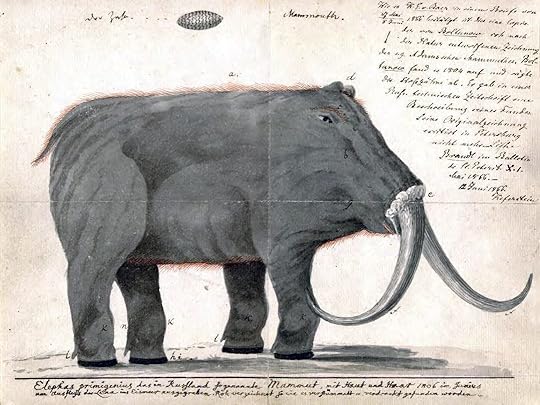 Drawing of an early 19th century attempt at a mammoth restoration. Note the upside-down tusks. (Image: WikiCommons/Public Domain)While the Lewis and Clark expedition didn't find any mammoths, the animals were still in the memory of the people they encountered. More than a century later, an anthropologist collecting stories in the Northwest was still hearing about them. In a footnote to his 1918 study, James Teit wrote that he was told of a very large animal, built like a hairy elephant, These animals, he said, had not been seen for several generations. but their bones were still found occasionally .
Drawing of an early 19th century attempt at a mammoth restoration. Note the upside-down tusks. (Image: WikiCommons/Public Domain)While the Lewis and Clark expedition didn't find any mammoths, the animals were still in the memory of the people they encountered. More than a century later, an anthropologist collecting stories in the Northwest was still hearing about them. In a footnote to his 1918 study, James Teit wrote that he was told of a very large animal, built like a hairy elephant, These animals, he said, had not been seen for several generations. but their bones were still found occasionally .Several generations? Since mammoths are thought to have gone extinct approximately 11,000 years ago, those are very long generations, indeed. But longer still is the memory of the people who were still telling stories about these creatures.
 Jennifer Bohnhoff is a former middle school and high school history and language arts teacher. She lives in the mountains of central New Mexico and write historical and contemporary fiction for middle grade through adult readers. She is available to lecture on the history behind her stories.
Jennifer Bohnhoff is a former middle school and high school history and language arts teacher. She lives in the mountains of central New Mexico and write historical and contemporary fiction for middle grade through adult readers. She is available to lecture on the history behind her stories.The booklinks in the above blog are for my recommended book lists on Bookshop.org, an online bookseller that gives 75% of its profits to independent bookstores, authors, and reviewers. If you click through my book lists and make a purchase on Bookshop.org, I will receive a commission, and Bookshop.org will give a matching commission to independent booksellers. But if you’re not looking to buy, browse my lists and find the books you’re interested in at your local library.
March 25, 2025
A Weekend to Remember

 This past weekend five friends and I participated in the Bataan Memorial Death March, which has taken place every March for the past 36 years. This was my tenth time to participate. I've completed both the full course, which is a 26.2 mile marathon, and I've participated in what they call the honorary course, which at 14.2 miles is a little longer than a standard half marathon. I've run the course and walked it, and I expect this time will be my last.
This past weekend five friends and I participated in the Bataan Memorial Death March, which has taken place every March for the past 36 years. This was my tenth time to participate. I've completed both the full course, which is a 26.2 mile marathon, and I've participated in what they call the honorary course, which at 14.2 miles is a little longer than a standard half marathon. I've run the course and walked it, and I expect this time will be my last.The march commemorates the forcible transfer of somewhere around 75,000 American and Filipino troops the Bataan Peninsula to prisoner of war camps following their surrender after the three-month Battle of Bataan during WWII. The transfer began on April 9, 1942. Depending on where they surrendered, the men marched up to 65 miles, many without any food or water. Those who broke out of formation to drink from pools of rainwater were shot, and those who could not keep up were bayoneted. Although different sources report widely differing numbers, casualty estimates for the mare range from 5,000 to 18,000 deaths for Filipino troops and 500 to 650 deaths for Americans.
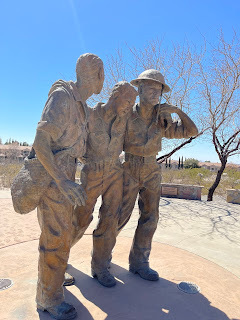 We'd trained for months to be ready for this event, walking in flat, sandy soils along the Rio Grande, on
We'd trained for months to be ready for this event, walking in flat, sandy soils along the Rio Grande, onthe rolling trails of the Sandia foothills, on city streets, and in forests. We'd gone to museums and parks that had memorials that were related to WWII and New Mexico's experience in it. I think we were ready, both mentally and physically. At the last memorial we visited, the Veteran's Park in Las Cruces, we viewed this sculpture, which shows three men, one looking back at what they have been through, one looking down at where they are, and one looking forward, into the future. Last year, we meet the son and nephew of two of the men whose faces were models for this art. They were participants in the march. His father survived. His uncle didn't. In years past, former POWs were there to tell their story and cheer us on as we marched in their honor. The last participant died recently. He was 105. Even though none of the survivors were there, the march was meaningful. Many of the marchers were related to men who had been in the march.
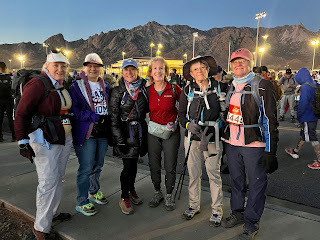 We began well before the sun was up, standing in line with the other marchers through a moving
We began well before the sun was up, standing in line with the other marchers through a movingopening ceremony. Then, just as dawn began lightening the eastern sky, the cannon boomed and the march began. Many of the marchers were in uniform, and some were carrying heavy packs. Others, honoring the men who carried their sick and wounded comrades during the original march, carried 8X8 posts, sawed off to weigh what a man would weigh. Many had pictures of their relatives pinned to their backs and were happy to talk about their relatives if asked. All of this made for a veery different experience than your regular marathon. This event is less a race than a walking memorial, a commemoration of the bravery of our WWII troops.
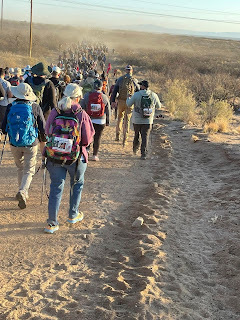 Much of the march was on dirt roads, and with 6,000 people and drought conditions, the trail was often dusty. But we had medics driving ATVs along the side of the course, checking for people who were struggling, and frequent aide stations where we received water, sports drinks, oranges and bananas. One station even offered pickles and cups of pickle juice!
Much of the march was on dirt roads, and with 6,000 people and drought conditions, the trail was often dusty. But we had medics driving ATVs along the side of the course, checking for people who were struggling, and frequent aide stations where we received water, sports drinks, oranges and bananas. One station even offered pickles and cups of pickle juice!
Five and a half hours and fourteen miles later, we crossed the finish line. We were tired, but elated to be a part of something so big and so meaningful. Our participation was a mere whisper of what the original marchers went through, and for that we were both humbled and grateful. It was a weekend to remember, and a weekend where remembering those who came before us and risked their all that we could live free was far more important than winning a race.
March 9, 2025
Places to go to Experience the Civil War in New Mexico
A lot of time has passed since the Civil War moved through New Mexico. During that time, the Rio Grande has moved its bed, obliterating the old battlefield. Asphalt roads have been laid down where trails used to be. Old buildings have been torn down and replaced by others. All this makes it impossible to see that a soldier might have seen back in the 1860s, but there are still places a interested person can go to see what this period might have been like. Here are a few suggestions. Call ahead to make sure that sites are open.
In Texas
The Military Forces Museum in Austin is housed in a 1918 mess hall and features thousands of war relics and historic photos representing every war from Texas Independence to the present. 512-782-5659
The Institute of Texan Cultures in San Antonio has exhibits about the different cultures that have come together in Texas. They have a small exhibit of Civil War artifacts. 210-458-2300.The route that Sibley took to get to New Mexico roughly follows I-90. The Army of New Mexico did not stop at Fort Lancaster, which is located near the town of Sheffield, near I-10, but the ruins of the fort are open and a good example of the kinds of forts that were in Texas at the time. 432-836-4391. Farther west, Fort Davis also has a self guided walking tour. 432-426-3224. Old Fort Bliss is a reconstruction of the adobe fort that existed at the time of the Civil War, and is open for tourists. There is also a military museum at the newer portion of Fort Bliss that has artifacts and exhibits. 915-568-4518 or 915-588-8482.In New Mexico
It wasn’t there at the time, of course, but when Sibley invaded New Mexico, he largely followed what is now the 1-25 corridor. Here are some places where you can see places mentioned in this story. Call ahead to verify that sites are open.
Old Mesilla was the Confederate western headquarters. Located south of Las Cruces, you can visit the plaza, where the Confederate flag hung. There are Civil War artifacts in the Gadsden Museum, which is located at 1875 W Boutz Rd in Mesilla 575-526-6293.
San Augustin Spring, where Major Isaac Lynde surrendered the garrison of Fort Fillmore to Confederate Lieutenant Colonel John R. Baylor, is just over 14 miles east of Las Cruces on I-70. The springs are not easy to access, but the drive up to San Augustin Pass helps explain why Lynde’s men were struggling in the summer heat, and the view of White Sands and the Tularosa Basin is spectacular.
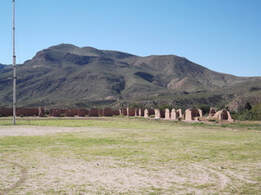 Ft. SeldenThe Army didn’t create Fort Seldon until 1865, but the Confederates created Camp Robledo there in 1861 to protect the northern entrance of the Mesilla Valley. The present-day State Monument has displays and self-guided tours that reflect 19th century military life, with a focus on the Buffalo Soldiers and Douglas MacArthur, who lived at the fort when he was a young boy. 575-526-8911.
Ft. SeldenThe Army didn’t create Fort Seldon until 1865, but the Confederates created Camp Robledo there in 1861 to protect the northern entrance of the Mesilla Valley. The present-day State Monument has displays and self-guided tours that reflect 19th century military life, with a focus on the Buffalo Soldiers and Douglas MacArthur, who lived at the fort when he was a young boy. 575-526-8911.
Only the bottom few feet of some adobe walls, the remnants of the stone jail, and some mounded dirt is all that’s left of Fort Craig, but the National Historic Site offers brochures and self-guided tours. 575-835-0412 From here, the Mesa de la Contadera looms up in the north, making it clear where the battle was fought. The actual battlefield is on private land and is inaccessible except by private tour. The Geronimo Springs Museum, in Truth or Consequences, has hosted these tours in the past. (575) 894-6600.
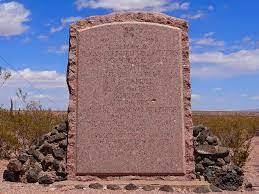 Close to the battlefield, on the west side of the Rio Grande is a Civil War Monument, erected in 1936, that honors the Confederate men and Texas Mounted Volunteers who died at the Battle of Valverde. To see it, take the San Marcial Exit off I-25 (A85) and go east. The monument is right near the entrance to the Armendariz Ranch. San Marcial, a small town built after the Valverde battle which is now a ghost town, is nearby. The town of Valverde, which was already abandoned by the time of the Civil War, was across the river from San Marcial.
Close to the battlefield, on the west side of the Rio Grande is a Civil War Monument, erected in 1936, that honors the Confederate men and Texas Mounted Volunteers who died at the Battle of Valverde. To see it, take the San Marcial Exit off I-25 (A85) and go east. The monument is right near the entrance to the Armendariz Ranch. San Marcial, a small town built after the Valverde battle which is now a ghost town, is nearby. The town of Valverde, which was already abandoned by the time of the Civil War, was across the river from San Marcial.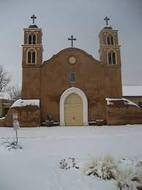 In past years, Socorro sponsored a reenactment of the Battle of Valverde on the weekend closest to the February 21 anniversary of the battle. The town also sponsors several historic walking tours that visit period houses around the plaza. 575-835-0424 The San Miguel church is also on the plaza. Both Pedro Baca and Manuel Armijo are buried there. (575) 835-2891. Some Civil War information can be viewed at the BLM office. (575) 835-0412 in Socorro.
In past years, Socorro sponsored a reenactment of the Battle of Valverde on the weekend closest to the February 21 anniversary of the battle. The town also sponsors several historic walking tours that visit period houses around the plaza. 575-835-0424 The San Miguel church is also on the plaza. Both Pedro Baca and Manuel Armijo are buried there. (575) 835-2891. Some Civil War information can be viewed at the BLM office. (575) 835-0412 in Socorro.
 Alfred Petticolas, a Confederate sergeant, sketched this picture of the Confederate flag flying in front of Albuquerque's San Felipe Church when southern troops occupied Albuquerque from March 2 to April 12, 1862. Albuquerque’s Old Town plaza no longer flies the Confederate flag (it was finally taken down in the early 2000s), but two cannons remain near the grandstand. The cannons are replicas of two of the eight cannons which the Confederates buried in a stable behind the church so they could use the guns’ carriages to carry supplies. The cannons were dug up in 1889.
Alfred Petticolas, a Confederate sergeant, sketched this picture of the Confederate flag flying in front of Albuquerque's San Felipe Church when southern troops occupied Albuquerque from March 2 to April 12, 1862. Albuquerque’s Old Town plaza no longer flies the Confederate flag (it was finally taken down in the early 2000s), but two cannons remain near the grandstand. The cannons are replicas of two of the eight cannons which the Confederates buried in a stable behind the church so they could use the guns’ carriages to carry supplies. The cannons were dug up in 1889. They are also said to have buried some of their dead – casualties of battle or illness – in Albuquerque, but no Confederate graves ever have been found in the Albuquerque area.
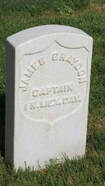 The National Cemetery in Santa Fe was created in 1867 as a result of John P. Slough's efforts to have proper burials for the soldiers killed at Glorieta. The first interments at the cemetery site were the remains of 265 U.S. soldiers taken from the battlefields of Glorieta, Kozlowsky's Ranch, and Fort Marcy. Later, the remains of five Confederate soldiers were removed from the Masonic Cemetery and reinterred in the Santa Fe National Cemetery. The cemetery also has the reinterred remains of soldiers from Fort Craig, which date from the Civil War era and include many Buffalo Soldiers from a later period. Captain James (Paddy) Graydon is buried in plot 9, C474. The cemetery also has a monument honoring the remains of 31 Confederate soldiers who were discovered in a mass grave on the site of the Glorieta battlefield on June 23, 1987 and were reinterred at the Santa Fe National Cemetery on April 25, 1993.
The National Cemetery in Santa Fe was created in 1867 as a result of John P. Slough's efforts to have proper burials for the soldiers killed at Glorieta. The first interments at the cemetery site were the remains of 265 U.S. soldiers taken from the battlefields of Glorieta, Kozlowsky's Ranch, and Fort Marcy. Later, the remains of five Confederate soldiers were removed from the Masonic Cemetery and reinterred in the Santa Fe National Cemetery. The cemetery also has the reinterred remains of soldiers from Fort Craig, which date from the Civil War era and include many Buffalo Soldiers from a later period. Captain James (Paddy) Graydon is buried in plot 9, C474. The cemetery also has a monument honoring the remains of 31 Confederate soldiers who were discovered in a mass grave on the site of the Glorieta battlefield on June 23, 1987 and were reinterred at the Santa Fe National Cemetery on April 25, 1993.
 Some of the heaviest fighting during the Battle of Glorieta Pass occured at Pigeon's Ranch. Built around 1857 by Alexander Vallé, a Frenchman known as Pigeon for his dancing style, this house is all that remains of his 23 room establishment that was a popular place to stay along the Santa Fe Trail. From 1926 to1937, when Route 66 passed right beside the house. it became a popular roadside attraction. All that remains is a single building which huddles, forgotten, along NM HW 50 just west of Pecos, New Mexico. The “Oldest Well in the U.S.A.” is still across the road from the ranch house. Pecos National Park holds what had been Kowzlowski's Ranch, where the Union made its headquarters for the Battle of Glorieta Pass. Their museum has some exhibits about the battle and, in the past, a Union and Confederate camp has been set up on the weekend closest to the date of the battle. A 2.3 mile Civil War Battlefield Trail can be accessed by checking in at the Visitor Center and getting a gate code from a ranger.
Some of the heaviest fighting during the Battle of Glorieta Pass occured at Pigeon's Ranch. Built around 1857 by Alexander Vallé, a Frenchman known as Pigeon for his dancing style, this house is all that remains of his 23 room establishment that was a popular place to stay along the Santa Fe Trail. From 1926 to1937, when Route 66 passed right beside the house. it became a popular roadside attraction. All that remains is a single building which huddles, forgotten, along NM HW 50 just west of Pecos, New Mexico. The “Oldest Well in the U.S.A.” is still across the road from the ranch house. Pecos National Park holds what had been Kowzlowski's Ranch, where the Union made its headquarters for the Battle of Glorieta Pass. Their museum has some exhibits about the battle and, in the past, a Union and Confederate camp has been set up on the weekend closest to the date of the battle. A 2.3 mile Civil War Battlefield Trail can be accessed by checking in at the Visitor Center and getting a gate code from a ranger.Planning to walk the Civil War Battlefield Trail? Here's a guide that supplements the one the forest service can sell you.
March 6, 2025
Mustard Sauce

Back in 1985, my husband and I spent a week on a schooner in the waters off Maine. We sailed among the islands, ate lobster on the beaches, and had a wonderful time.
One of the meals we had was a New England boiled beef dinner, with carrots and cabbage and potatoes and a wonderful mustard sauce.
I don't think I've made boiled beef since then, but I've made many, many jars of the mustard sauce. We use it for corned beef every March, and for sandwiches and on ham. It's simple, made of ingredients that are household staples, but it adds a zing to a lot of different foods.
I'll be making a batch before St. Patrick's Day. If you do, too, let me know what you think!
Mustard Sauce
Stir together (in a double boiler if you have one. I don't, and it turns out just fine)2 TBS dry mustard
1 tsp flour
1/2 tsp salt1/4 cup sugar
Add in, stirring a bit at a time until it is mixed in well and there's no lumps
1 cup evaporated milk
Slowly heat up, stirring constantly. When it is hot but not quite bubbling, add and stir1 beaten egg yolk
Slowly drizzle in, while still stirring1/2 cup heated cider vinegar
Take off heat and pour into glass jars. Store in refrigerator.
February 26, 2025
In the Shadow of Sunrise ARC now available!
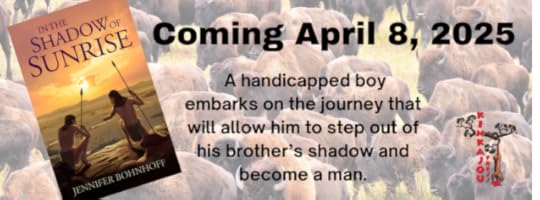 In the Shadow of Sunrise, my middle grade novel set in the American Southwest 10,000 years ago, will be coming out on April 8, 2025.
In the Shadow of Sunrise, my middle grade novel set in the American Southwest 10,000 years ago, will be coming out on April 8, 2025. I'd love it if it opened to great reviews! That's what ARCs - Advanced Reader Copies - are all about.
If you'd like to read this book before it comes out, click here.

In the Shadow of Sunrise tells the story of Earth Shadow, a bow who was born the smaller and weaker of twin brothers. Earth Shadow is anxious to step out of the shadow of Sunrise, his physically stronger twin brother. The two are now old enough to join their clan’ s adults on the annual Walk Around, a summer-long journey to gather stones for implements and connect with other clans. He worries that if he doesn’ t participate in the hunt that will take place at the Great Gathering of all the clans, this Walk Around will be his last, and he will spend the rest of his summers staying behind with the sick, elderly, and very young. As he listens to Grandmother's stories of the ancestors, Earth Shadow discovers that his creativity and reasoning may be as important to the survival and success of the clan as his brother's hunting skills.
This is a coming of age story set in a very different time, yet young boys then feel much the same way as young boys now about the future and their place within it.

The places visited during the Walk Around are all places where archaeologists have found evidence of Folsom occupation. Located in what is now Southern Colorado, Northwestern Texas, and New Mexico, many of the sites are open to the public now.
This book would be an excellent social studies/literature tie in for grades 4-9. A teacher's guide and powerpoint presentation are available through the author.
February 16, 2025
Real People in REBELS ALONG THE RIO GRANDE
Although the main characters in Rebels Along the Rio Grande are fictitious characters, almost all of the background characters are real, historical people. Here are a few of the most famous:
 Illustration by Ian Bristow from Where Duty Calls
Illustration by Ian Bristow from Where Duty CallsChristopher "Kit" Carson (December 24, 1809 – May 23, 1868) is perhaps the most famous Indian Scout, mountain man, and frontiersman of all time. Carson left his home in rural Missouri when he was only 16 to become a mountain man and trapper in the rugged Rocky Mountains. By the time of the Civil War, he had added wilderness guide, Indian agent, and U.S. Army officer to his resume. Carson was a legend in his own lifetime, and his exploits, although greatly exaggerated, appeared in dime novels.Carson was a quiet man, short in stature, and uncomfortable with his own celebrity In Where Duty Calls, he is mending his own clothes when he meets Raul for the first time at Fort Craig. Carson was then leading a division of New Mexico Volunteers.
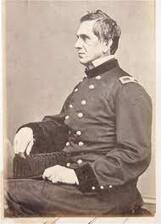
Edward R.S.Canby (November 9, 1817 – April 11, 1873) was a West Point graduate who was in command of New Mexico territory's Fort Defiance when the Civil War broke out. He was appointed colonel of the 19th Infantry on May 14, 1861 and made commander of the Department of New Mexico after the man who had been commander left to join the Confederacy.
More an administrator than a fighter, Canby was a cautious and careful leader. He realized that defending the entire territory from every possible attack would stretch his forces too thinly, so he amassed his troops at Fort Craig, to guard the route up the Rio Grande. He was defeated at the Battle of Valverde, but managed to retain the fort and keep its precious stores of food and arms out of enemy hands. Eventually, this forced the Confederates to abandon their campaign and return to Texas.
Canby made no secret of his distain for the New Mexico Volunteers. His reports blamed them for more cowardice and incompetence than they deserved.
Canby was killed in 1873 while attending peace talks with the Modoc in the Pacific Northwest. He was the only United States general to be killed during the Indian Wars.
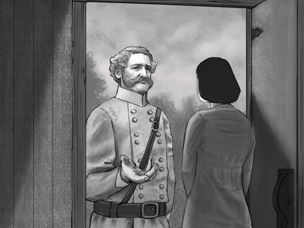 Illustration by Ian Bristow in The Famished Country
Illustration by Ian Bristow in The Famished Country Henry Hopkins Sibley (May 25, 1816 – August 23, 1886) was also a West Point graduate who was serving in New Mexico territory at the outbreak of the Civil War. He resigned his commission on May 13, 1861, the day of his promotion to major in the 1st Dragoons and joined the Confederate Army. Sibley convinced Confederate President Jefferson Davis to put him in command of a brigade of volunteer cavalry in West Texas, which he named the Army of New Mexico. Sibley's intention for the New Mexico Campaign was to capture Fort Union on the Santa Fe Trail and make it a forward base of supply. He would then capture the gold and silver mines of Colorado and the warm-water ports of California. Sibley was accused of alcoholism during his time in New Mexico. Before the war ended, he had been court martialed and censured. After the war, he served as an advisor for the Egyptian Army, but continued to struggle with alcoholism. He died in poverty.
Rebels Along the Rio Grande is a trilogy of middle grade historical novels set in New Mexico during the American Civil War. The author, Jennifer Bohnhoff, taught middle and high school English and History and is available to speak with classes and interested groups about the history behind these novels.
February 10, 2025
Doomed World - Again
If you read the papers or listen to the news, but becomes clear that the world is doomed. We are destroying our air. The seas are rising. The ice caps are melting. We are doomed.
This isn't the first time we've teetered on the edge of total destruction. There's a reason our folklore, our myths, and our movies are filled with apocalyptical stories. In Atlas of a Lost World, writer Craig Childs tells of another time the world as we knew it was ending. It happened a long time ago. Before we could shoot a movie about it, or write a book.. There aren't even clay tablets telling about how the world was changing in catastrophic ways. The records are written, not by man, but by nature, in the rocks that geologists and anthropologists study.The time I'm talking about was at the end of the last Ice Age. Like today, temperatures were rising. Ice caps were melting. Places that had been habitable, like the Doggerland, north of Britain, half of Florida, and the Beringia, the 500 mile land bridge that linked Alaska to Siberia, were sinking under the rising seas. And that wasn't the worst of it. About 13,000 years ago, a glacier dam in Montana broke. The deluge it released took out half of Washington State, and some of Oregon and Idaho. Everything but the highest buttes and mountains were flooded and large portions of the landscape were washed away. Points and projectiles buried in the piles of debris left from this debacle indicate that people might have been there to watch the devastation. Those who survived would have been standing on tall buttes as the water thundered by. They might have felt like Noah standing on the bridge of the ark - like the entire world was being erased by water. After it was over, they would have climbed down into a world of mud and chaos to begin their lives anew.At about the same time, volcanos in central Mexico were going through a series of eruptions. They filled the air with smoke and cinders, darkening the sky and making breathing difficult. Scientists have found mammoth bones entombed in the igneous ash, the flesh cooked away in the intense heat.. They've also found human artifacts that show that people were there to witness this hellish environment.Although not all scientists agree, a comet might have exploded high up in the atmosphere over North America at about the same time. No impact site has been found, but archaeologists and geologists have detected a layer of soil that dates from about this period containing pellets of silica that might be the remnants of this explosion. The sonic boom as this explosion produced must have sounded like the trumpet to end all time, the rain of molten silica terrifying and, for some, deadly.The worst catastrophe of the time might actually have been recorded. A carved stone pillar in Gobekli, Turkey seems to record the core collapse of a super nova. about 12,830 years before the present. Such an event would have pelted the earth with doses of UV that would have been deadly to marine life and plants. The sudden brightening, then disappearance of a star would have been disturbing, even if the consequences were not understood by the ancient peoples who witnessed and recorded the event. Add these events to the thousands of years of epic flooding and rise of sea level brought on by the end of the Ice Age, and it is clear that those who lived at this time might have thought that their world was ending. For the megafauna who lived then - the mammoths and giant ground sloth to name a few, it really was the end.February 2, 2025
Book Review: Miya's Mountain
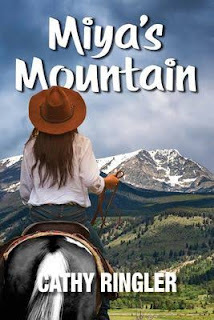
Fifteen-year-old Miya Skippingbird knows that she's let the family down. Her impulsiveness and lack of attention to detail has frustrated her father so much that he no longer trusts her to do what she's promised. She convinces him to give her one last chance, and he agrees to let her lead a cocky city slicker and his son on a trail ride and fishing expedition into the mountains. If she's successful, she'll prove that she can be trusted, and she's help relieve the burden on her financially strapped parents.
But once the party is in the mountains, a massive rockslide traps them and one of the party becomes seriously ill. Miya is the only one who can cross the treacherous summit and go for help, but she must overcome her all-consuming anxiety and her paralyzing fear of heights to do so, and even her best friend, Jake Runningdeer can't help her.
When things are at their worst, she does get help -- from a grizzly bear! No, this isn't fantasy. What happens is very believable, but you'll have to read it to understand.
This middle grade adventure novel is perfectly paced and kept me turning pages long after I was supposed to set the book aside. I really felt for the characters and wanted to know how things would turn out.
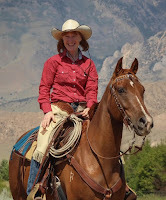 About the author
About the author Cathy Ringler is a storyteller, cowgirl, and retired teacher. She lives at the foot of the beautiful Beartooth Mountains and rides in them as often as her busy schedule will allow. Her experience in the saddle and around horses really shines through in Miya's Mountain. Her details about saddling and watching the body language of horses will ring true to anyone who's been around horses.
There are discussion questions in the back of the book which make this a perfect read aloud for 4th-7th grade classes, and would make a great choice for book clubs in elementary and middle schools.
If you'd like Jennifer Bohnhoff's gently used copy of Miya's Mountain, leave a comment below. I'll pick on commenter to mail the book to.
February 1, 2025
Belying the Bells and Whistles
 Everyone wants all the bells and whistles. We want the latest and greatest and most state-of-the-art thingy available, and we want it as soon as it's available.
Everyone wants all the bells and whistles. We want the latest and greatest and most state-of-the-art thingy available, and we want it as soon as it's available.This yearning for the new is very apparent in my students. I teach middle school. Very few of my students have no cell phone. Most not only have a cell phone, but they have a state-of-the-art model. They are proud to show you that theirs is the latest and the greatest. It has all the bells and whistles.
This isn't always to their advantage. For many, their phones are more of a distraction than an aide to their education. I've often been asked if they could use an ap to look up word definitions or spellings, only to find my students distracted by games or texts from their friends.
Last week in my advisory class we talked about good academic habits. Among those habits was treating one's body well: eating good food, getting enough exercise, and getting enough sleep. When I mentioned that one way to ensure a good night's sleep is to turn off one's cell phones, a number of my students errupted into protests. How could they be expected to turn their phones off? Their phones were their alarm clocks! I suggested they might turn them to 'alarm only.'
"I can't do that," one girl said, despair dripping from her voice. "I might miss something."
And so I've come to realize that many of my students are not getting enough sleep at night because they are afraid of missing something, afraid of missing the next big thing. They have becomes slaves to their bells and whistles.
When I published my first novel, I published it as an ebook. Even though I'd never read an ebook and didn't own a kindle or a nook, I'd read plenty of experts who said that ebooks were the next big thing, the state-of-the-art, bell and whistle way to read. Ebooks were going to revolutionize the way books were marketed and the way books were read. If this was the wave of the future, I wanted to catch it.
One of the big arguments for technology was that it would make information more accessible for more people. E-readers would make even remote villages in third world countries would have access to huge stores of information. Specialized software was going to make the written word accessible to people with handicaps that made reading impossible. The promises were exciting indeed.
But the wave of the future hasn't been the Banzai pipeline to fame and fortune that I was given to believe. While I've had some success with ebooks, I've had much more luck with my paperback editions. Many of my readers tell me they like the feel of real paper in their hands. They like the smell of it. The heft of it. They like turning the page. Somehow, in spite all the expert opinions, the tried and true has won out over the state-of-the-art.
So maybe the latest and the greatest has some value. Perhaps from those bells and whistles we will develop new ways of reading that will help those who cannot read right now. We will develop audio books and books that scan and scale to help those with disabilities. We will be able to distribute more books to people who live hundreds of miles from libraries, and put whole libraries into the hands of those who've never owned even one book.
Let us make sure that we control those bells and whistles instead of letting them control us.
Remembering
 Today we remember the four terrorist attacks that were launched on America by the terrorist group al-Qaeda thirteen years ago.
Today we remember the four terrorist attacks that were launched on America by the terrorist group al-Qaeda thirteen years ago.Or we don't.
The 2001 attacks on New York City and Washington D.C. killed almost 3,000 people and left millions with long term respiratory and immune system problems. It caused at least $10 billion in property and infrastructure damage and disrupted business and travel for weeks. And it changed the American psyche, as we realized that we, too, were vulnerable to the violence and mayhem that has characterized the Middle East for a long time.
The American people vowed that we would never forget. We taught about 9/11 in our classrooms. We observed moments of silence and produced special inserts in the papers, programs on TV, movies and books. We constructed memorials, including the National September 11 Memorial and Museum in New York, the Pentagon Memorial in Washington, and the Flight 93 National Memorial in Shanksville, Pennsylvania.
But for many, the events of 9/11 faded into the past. Our own personal lives, filled with tiny triumphs and defeats took precedence.
It is not surprising that the significance of 9/11 has faded for many people in our nation. This, after all, is not the first event that we vowed to never forget.
Remember Pearl Harbor? Remember the Maine? Few of my students could tell you anything about either of these unforgettable events.
This is one compelling reason for reading historical fiction. Historical fiction reminds us of who we once were and what we went through in our past. It personalizes bygone eras so that we can enter into them and see them through fresh eyes. Through these eyes we remember not only the huge events of history, but the tiny triumphs and defeats of other, long ago personal lives. We realize that we are a part of that long, hopeful line that stretches back through countless generations, each with a story to tell.
And we remember.



